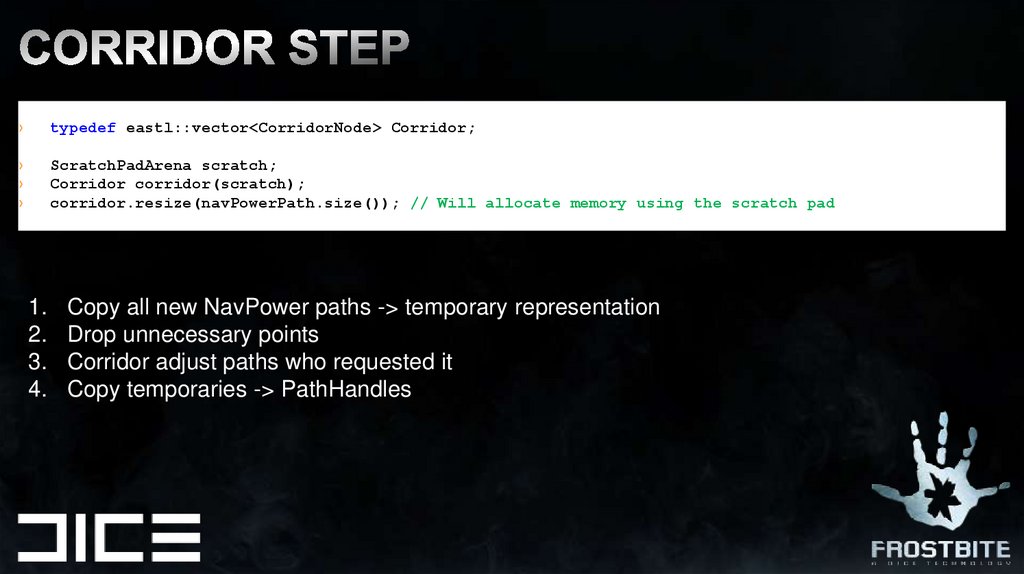Similar presentations:
A step towards data orientation
1. A step towards data orientation
JOHAN TORPDICE CODERS DAY 3/11 2010
<JOHAN.TORP@DICE.SE>
2. AGENDA
› AI decision making - Pathfinding - Animation› Look at actual code & patterns
› Questions
3. IN an OO WORLD
AI DECISION MAKINGOO
PATHFINDING
ANIMATION
NAVPOWER
OO
OO
4. DECISION TO MOVEMENT
5. DECISION TO MOVEMENT
6. DECISION TO MOVEMENT
7. DECISION TO MOVEMENT
8. DECISION TO MOVEMENT
9. NAVPOWER OPERATIONS
››
›
›
›
›
Find path
Load / unload nav mesh section
Add / remove obstacles
Path invalidation detection
Can go-tests
“Raycasts”, circle tests, triangle tests
10. ABSTRACTIONS
› Pathfinder - find path, path invalidation, circle tests, raycasts› Random position generator - can go-tests
› Manager - load nav mesh, obstacles, destruction, updates
Left some raycasts synchronous
11. Pathfinder INTERFACE
››
›
›
›
›
›
interface Pathfinder
{
public:
virtual PathHandle* findPath(const PathfindingPosition& start,
const PathfindingPosition& end,
Optional<float> corridorRadius,
PathHandle::StateListener* listener) = 0;
›
›
›
›
›
/// More efficient version of findPath when start is the end of a previous path
///
/// @pre lastPath->getState() == PathHandle::ValidPath
virtual PathHandle* findPathFromDestination(PathHandle* lastPath,
const PathfindingPosition& end,
Optional<float> corridorRadius,
PathHandle::StateListener* listener) = 0;
›
virtual void releasePath(PathHandle* path) = 0;
›
›
virtual bool canGoStraight(Vec3Ref start, Vec3Ref end, Vec3* collision = nullptr) const = 0;
};
12. PATH HANDLE
››
typedef fixed_vector<Vec3, 16> WaypointVector;
typedef fixed_vector<float, 16> WaypointRadiusVector;
›
›
›
struct PathHandle
{
enum State {ComputingPath, ValidPath, NoPathAvailable, RepathingRequired};
›
›
›
interface StateListener {
virtual void onStateChanged(PathHandle* handle) = 0;
};
›
PathHandle() : waypoints(pathfindingArena()), radii(pathfindingArena()) {}
›
›
WaypointVector waypoints;
WaypointRadiusVector radii;
›
›
State state;
};
13. PATH HANDLE
››
typedef eastl::fixed_vector<Vec3, 16> WaypointVector;
typedef eastl::fixed_vector<float, 16> WaypointRadiusVector;
›
›
›
struct PathHandle
{
enum State {ComputingPath, ValidPath, NoPathAvailable, RepathingRequired};
›
›
›
interface StateListener {
virtual void onStateChanged(PathHandle* handle) = 0;
};
›
PathHandle() : waypoints(pathfindingArena()), radii(pathfindingArena()) {}
›
›
WaypointVector waypoints;
WaypointRadiusVector radii;
›
›
State state;
};
14. NAVPOWER PATHFINDER
››
›
›
›
›
class NavPowerPathfinder : public Pathfinder
{
public:
virtual PathHandle* findPath(...) override;
virtual PathHandle* findPathFromDestination(...) override;
virtual void releasePath(...) override;
virtual bool canGoStraight(...) const override;
void updatePaths();
void notifyPathListeners();
›
›
›
›
›
private:
bfx::PolylinePathRCPtr m_paths[MaxPaths];
PathHandle m_pathHandles[MaxPaths];
PathHandle::StateListener* m_pathHandleListeners[MaxPaths];
u64 m_usedPaths;
›
›
typedef eastl::fixed_vector<PathHandle*, MaxPaths, false> PathHandleVector;
PathHandleVector m_updatedPaths, m_updatedValidPaths;
};
15. CORRIDOR STEP
›typedef eastl::vector<CorridorNode> Corridor;
›
›
›
ScratchPadArena scratch;
Corridor corridor(scratch);
corridor.resize(navPowerPath.size()); // Will allocate memory using the scratch pad
1.
2.
3.
4.
Copy all new NavPower paths -> temporary representation
Drop unnecessary points
Corridor adjust paths who requested it
Copy temporaries -> PathHandles
16. CORRIDOR STEP 2-4
››
const CorridorHandleVector::iterator allBegin = all.begin(), allEnd = all.end();
const CorridorHandlePtrVector::iterator adjustBegin = adjust.begin(), adjustEnd = adjust.end();
›
›
for (CorridorHandleVector::iterator it=allBegin; it!=allEnd; ++it)
dropUnnecessaryPoints(it->corridor, scratchPad);
›
›
for (CorridorHandlePtrVector::iterator it=adjustBegin; it!=adjustEnd; ++it)
shrinkEndPoints((**it).corridor, m_id);
›
›
for (CorridorHandlePtrVector::iterator it=adjustBegin; it!=adjustEnd; ++it)
calculateCornerDisplacements((**it).corridor);
›
›
for (CorridorHandlePtrVector::iterator it=adjustBegin; it!=adjustEnd; ++it)
displaceCorners((**it).corridor, m_id);
›
›
for (CorridorHandlePtrVector::iterator it=adjustBegin; it!=adjustEnd; ++it)
shrinkSections((**it).corridor, m_id);
›
›
}
for (CorridorHandleVector::iterator it=allBegin; it!=allEnd; ++it)
copyCorridorToHandle(it->corridor, *it->handle);
17. NavPOWER MANAGEr
››
void NavPowerManager::update(float frameTime)
{
m_streamingManager.update();
m_destructionManager.update();
›
m_obstacleManager.update();
›
bfx::SystemSimulate( frameTime );
›
›
for (PathfinderVector::const_iterator it=m_pathfinders.begin(), ...)
(**it).updatePaths();
›
for (PathfinderVector::const_iterator it=m_pathfinders.begin(), ...)
(**it).notifyPathListeners();
›
›
›
›
for (PositionGeneratorVector::const_iterator it=m_positionGenerators.begin(), end = ...)
(**it).update();
}
18. BATCHING BENEFITS
››
›
›
Keep pathfinding code/data cache hot
Avoid call sites cache running cold
Easier to jobify / SPUify
Easy to timeslice
19. Asynchronous
› Manager› Random position generator
› Pathfinder
Collect destruction messages, process in batch
Runs ~1/sec. Allows synchronous decisions
Decision making assumes success
20. LESS SIMPLIFIED ARCHITECTURE
SCRIPTINGSERVER
CLIENT
AI DECISION MAKING
PATH FOLLOWING
PATHFINDING
NAVPOWER
DRIVING
VEHICLE INPUT
LOCOMOTION
LOCOMOTION
Waypoints
Waypoint Data
Corridor Radii
ANIMATION
21. My precious latency
Each server tick1. Each AI decision making
2. Pathfinding manager update
All pathfinding requests
All corridor adjustments
All PathHandle notifications -> path following -> server locomotion
3. Network pulse. Server locomotion -> client locomotion
4. ...rest of tick
22. Asynchronous EXAMPLES
››
›
›
›
Callbacks. Delay? Fire in batch?
Handle+poll instead of callbacks. Poll in batch.
Record messages, process all once a frame
Check success / failure next frame
Pre-calculate what you’re likely to need
Con: Callstack won’t tell you everything.
...but can we afford deep callstacks?
23. RESOLVE EARLY
››
›
›
›
void Bot::changeVehicle(const ServerEntryComponent* entry)
{
...
m_pathFollower = entry->owner()->
getFirstComponentOfType<ServerPathFollowingComponent>()->getPathFollower();
}
24. BE NICE TO YOUR MEMORY
new / push_back() / insert() / resize()Stop and think!
›
›
›
›
›
›
Where is the memory allocated?
Pre-allocated containers?
Scratch pad?
Can I resize()/reserve() immediately?
Can I use Optional<T> instead of ScopedPtr<T>?
Can I use vectors instead of list / set / map?
25. Let’s START MOVING
› Let’s not abandon OO nor rewrite the world› Start small, batch a bit, resolve inputs, avoid deep dives, grow from there
› Much easer to rewrite a system in a DO fashion afterwards
26. SUMMARY
AI decision making – pathfinding – animationCode: Handles, arena, scratch pad, fixed_vector, batch processing
Latency analysis, async patterns
Think about depth/width of calls, try stay within your system, resolve early,
new/push_back() = think



























 informatics
informatics








